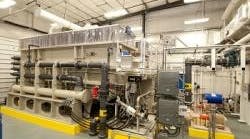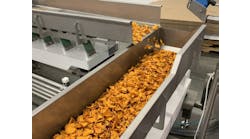"Water scarcity is a growing national and global problem," says Mohammad Haghighipodeh, corporate sustainability manager for the Frito-Lay North America division of PepsiCo.
He was in charge of identifying the objectives, technologies, design and proving-out of Frito-Lay's Casa Grande, Ariz., potato chip-making plant. The 28-year-old plant in Arizona's Sonoran Desert is a showcase for many "green" technologies, including solar power, a biomass boiler system that turns solid waste into steam and a plant-wide effort to reduce landfill waste to nearly zero.
A central part of the effort is a total systems approach to water reduction, which results in lower water intake and 75 percent of the process water being reused. The centerpiece is a membrane bioreactor (MBR) and low-pressure reverse-osmosis system. GE Water & Process Technologies, Trevose, Pa., commissioned the MBR portion of the wastewater treatment plant in 2010.
But an important preliminary step was looking at the process. Frito-Lay engineers redesigned the cooking process for corn used in the tortilla chips in such a way that 40 percent of the water from one batch was left in the tanks for the next batch, saving both water and the energy to heat it.
That total systems approach to wastewater treatment is advocated by World Water Works Inc., Oklahoma City, Okla. "The approach includes a collaborative evaluation process to understand a particular facility’s requirements, use of proven designs and materials and selection of innovative products that have the best lifecycle cost while achieving the best water quality," says Chandler Johnson, chief technology officer at World Water Works (WWW).
Components included in a total systems approach vary depending upon the application. The two main categories include primary and secondary liquid/solid separation to remove particulates and organics and biological treatment of soluble biochemical oxygen demand (BOD) and ammonia. Related equipment may include pump stations, screening devices, sludge tanks and a range of other ancillary equipment to handle any byproducts created.
Johnson cites as an example a 2011 upgrade of wastewater treatment system at Dannon Co.’s West Jordan, Utah, yogurt plant. "Just two years prior, the company had installed a circular dissolved air flotation (DAF) pretreatment system but had found that it was not well-designed, with high operational costs from chemical consumption and poor performance," Johnson says.
Dannon also was concerned that the existing plant would not be able to handle additional wastewater expected from a planned facility expansion, so the company decided to construct a new wastewater treatment system. After evaluating several possible technologies, including both anaerobic and aerobic solutions, they selected a system that uses two rectangular high-rate DAF units, one for separation of suspended solids and fats, oils and greases and one for separation of biological solids. The DAF selected has the added benefit of handling pH swings without corrosion.
In addition, a moving bed biofilm reactor (MBBR) degrades soluble organics. MBBR is a biological process used for biological oxygen demand (BOD) removal, nitrification and/or denitrification. The system provides significant advantages over other biological processes and has been successfully implemented at several dairies, which have widely variable wastewater loads. Aside from the core DAF and MBBR technologies, the total system also includes rotary screening to remove debris and equalization to normalize the flow and load.
The plant began treatment and within a few weeks the DAF units were operating at a fraction of the costs of the previous unit. The system has been designed so it can be expanded easily to meet further production needs. It is a flagship site for Dannon, and the plant has won awards at prestigious environmental conferences in the food industry.
World Water Works also used a total systems approach for a Hillshire Brands (then Sara Lee) turkey processing plant in Iowa, which needed to expand its wastewater treatment.
WWW suggested beginning with a DAF-EQ-DAF system and then conducting a further evaluation to determine if biological treatment was needed at all. The evaluation step gave the company time to review the impacts from the initial system and ask questions about what could be achieved with the effluent if additional treatment was added. The evaluation took place over the course of about nine months.
The company decided to add an MBBR to the treatment line, which reduced its BOD and TSS to single digits. The load reduction means the municipality now has significant additional capacity and will not have to expand its facilities to build any needed capacity.
"Focusing on the total system as a whole is important because zoning in on only one specific component may result in missing the bigger part of the picture," says Johnson. "Even if a company needs to replace only one piece of its system or add a new component, the project should still include the same elements, with a focus on complete problem evaluation and provision of a solution tailored to the company’s individual needs."


